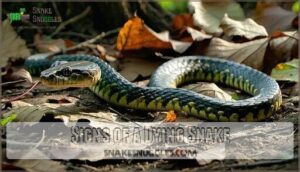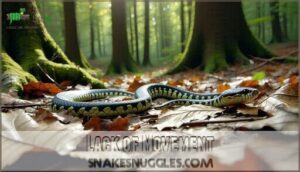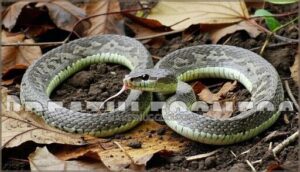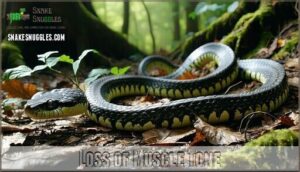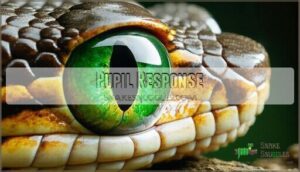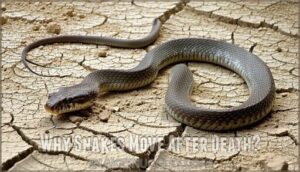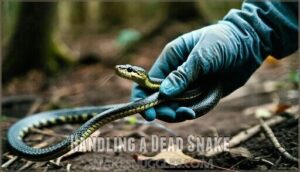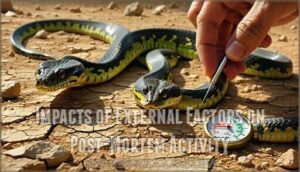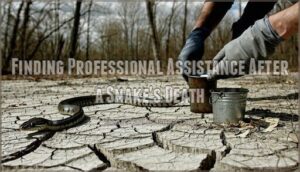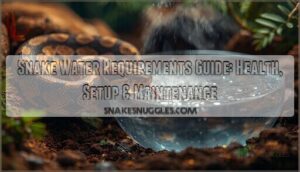This site is supported by our readers. We may earn a commission, at no cost to you, if you purchase through links.

Sometimes, their muscles twitch or spasm due to nerve reflexes, which might flip them onto their back. It’s not a conscious action—just biology doing its thing.
Other times, they stay in whatever position they were in when they passed. Factors like how they died, their environment, or even gravity can play a role.
It’s a bit like when your leg twitches after you’ve been sitting too long—just on a more final level. Curious about why snakes can still move after death? Stick around for some fascinating science.
They can still move due to the way their bodies react after passing, and understanding this can be quite interesting.
Table Of Contents
- Key Takeaways
- Do Snakes Roll Over When They Die?
- Signs of a Dying Snake
- Behavioral Changes in Dying Snakes
- Physical Manifestations of Snake Dying
- Why Snakes Move After Death?
- Post-Mortem Movement in Snakes
- Handling a Dead Snake
- Can a Dead Snake Still Bite?
- Impacts of External Factors on Post-Mortem Activity
- Cultural and Mythological Views of Dead Snakes
- Finding Professional Assistance After a Snake’s Death
- Frequently Asked Questions (FAQs)
- Why do snakes move after they die?
- What happens when a snake dies?
- Do dying snakes lay on their backs?
- Do snakes play dead?
- Do snakes flatten their heads when playing dead?
- What happens when you touch a dead snake?
- What do snakes do when they die?
- What does it mean when a snake rolls over?
- Why do snakes roll over?
- Will snakes move after they die?
- Conclusion
Key Takeaways
- You shouldn’t expect snakes to roll over when they die—it’s mostly a myth, though their flexible spines and muscle relaxation can sometimes cause their bodies to flip or twist unnaturally after death.
- You’ll see dead snakes continue moving through nerve reflexes and muscle contractions that can last for hours, including twitching, jerking, and even jaw snapping—these aren’t signs of life but leftover biological responses.
- You need to handle dead snakes carefully since they can still bite reflexively and inject venom, so always use gloves and tools like tongs to avoid direct contact with the head area.
- You can identify a dying or dead snake by watching for complete stillness, lack of breathing, unresponsive pupils, and extreme limpness—but don’t let post-mortem movements fool you into thinking it’s alive.
Do Snakes Roll Over When They Die?
It’s a common misconception that snakes roll over when they die, but this isn’t true. The idea, often called the Rolling Over Myth, likely comes from observing unusual post-mortem movements.
However, these movements—like twitching or jerking—are caused by nerve reflexes and muscle contractions, not intentional actions. Snakes don’t perform a dramatic “death roll” as seen in some animals.
Instead, their snake anatomy, with its flexible spine, may cause the body to collapse or twist unnaturally after death. This can sometimes look like rolling. Factors like Rigor Mortis Role and gravity also influence their final position, but they don’t actively roll over.
Inadequate humidity can also lead to respiratory and shedding issues. If you’re unsure whether a snake is dead, watch for snake death signs like limpness or unresponsiveness. Always handle with caution—reflexes can still surprise you!
Signs of a Dying Snake
How do you tell when a snake is nearing its end? Look for unusual positioning, like lying flat and motionless.
A dying snake shows reflex slowdown, with no reaction to touch or sound. Its tongue changes, flicking less frequently or stopping altogether. You might notice an activity decrease, where it becomes lethargic and unresponsive.
Other physical signs include dilated pupils that don’t respond to light and a limp, floppy body. One key indicator is the lack of breathing, which suggests respiratory distress.
While these snake death signs are clear, don’t confuse them with post-mortem reflexes like twitches. Understanding snake dying symptoms helps you distinguish between life and involuntary movements, ensuring you handle the situation safely.
Behavioral Changes in Dying Snakes
When a snake is nearing the end, its behavior can shift in ways that might surprise you.
These pre-death actions often include odd or dramatic displays that stand out from its usual habits. You might notice:
- Erratic tongue behavior, like less frequent flicking or unusual patterns
- Reflex slowing, with movements becoming clumsy and uncoordinated
- Unusual positioning, such as lying flat or hiding in cooler areas
Some species, like the Eastern Hognose, take things up a notch with theatrical snake death throes—rolling over, mouth wide open, and even emitting a foul smell. These antics mimic snake rolling over behavior but are more about survival theatrics than actual death.
If your snake refuses food or water and seems lethargic, these could be snake dying symptoms. While these actions may look alarming, they’re part of the natural progression of snake body language death.
Physical Manifestations of Snake Dying
When a snake is dying, its body shows clear physical signs like breathlessness and limpness.
You might also notice unresponsive pupils and a complete lack of movement, which can seem eerie but are natural indicators of death.
Lack of Movement
Identifying immobility in a dead snake is straightforward—there’s no reaction to touch, sound, or movement.
This lack of movement sets it apart from mimicking brumation or snake death throes.
Dead snake behavior includes a limp body, unresponsive muscles, and no rigidity unless rigor mortis has begun.
Despite appearing lifeless, it’s important to remember that residual nerve activity can cause post-mortem movements. Unlike snake rolling over in defense, stillness defines death unmistakably.
Breathlessness
Breathlessness is a telltale sign of a dying snake.
You’ll notice no chest movement or airflow from its nostrils—like a balloon with no air left.
Unlike postmortem behavior or reflexes, this stillness signals respiratory shutdown.
It’s not a hognose’s dramatic act but a genuine lack of life.
Causes like oxygen deprivation lead to complete systemic failure.
Loss of Muscle Tone
After death, a snake’s loss of muscle tone leads to extreme limpness, making its body floppy and unable to hold form.
Without muscle support, spinal flexibility and gravity’s effect can cause the body to collapse unnaturally.
- Rigor mortis temporarily preserves the snake’s death position.
- Muscle relaxation can mimic a snake rolling over.
- Posture preservation depends on environmental factors.
Pupil Response
As a snake nears death, its pupil response fades.
You’ll notice pupil dilation or fixed pupils that no longer react to light.
This lack of response signals neurological shutdown.
Unlike myths of a snake "rolling over," these changes confirm its condition.
If unsure, seek a veterinary assessment to rule out brumation or other issues.
Eyes often reveal the truth.
Why Snakes Move After Death?
You might find it surprising, but a snake’s body can still twitch or jerk after death.
These movements happen because of nerve reflexes and muscle contractions, not because the snake is alive.
Nerve Reflexes
Sometimes, even after death, a snake might twitch or jerk unexpectedly.
This is due to post-mortem reflexes, where the residual nervous system activity sparks involuntary actions like muscle contractions.
The reflex arc operates independently of the brain, responding to stimuli.
These movements can last minutes or hours, depending on the reflex duration, but they’re just leftover signals—not signs of life.
This can happen because of residual neural activity within the reptile’s nervous system.
Muscular Contractions
Muscle contractions after death can seem eerie but are completely normal.
These involuntary muscle contractions occur due to lingering nerve reflexes and environmental triggers. You might notice twitching or jerking, which doesn’t mean the snake’s alive.
- Contraction triggers include touch or temperature changes.
- Reflex strength varies by species.
- Rigor duration eventually halts all postmortem activity.
It’s science, not sorcery!
Spasmodic Movements
Even after death, snakes can surprise you with spasmodic movements caused by nerve reflexes and muscle contractions.
These postmortem reflexes might include muscle twitching or sudden jerks. Environmental factors like touch or temperature changes can act as movement triggers.
Check out this breakdown:
| Trigger | Effect | Duration |
|---|---|---|
| Touch | Muscle twitching | Short-lived |
| Temperature change | Reflex duration extends | Up to an hour |
| Rigor mortis onset | Reduced spasms | Gradual decline |
| Venomous spasms | Stronger contractions | Potentially dangerous |
It’s fascinating yet harmless—unless handling venomous snakes!
Post-Mortem Movement in Snakes
When a snake dies, its body can still exhibit movements that might catch you off guard.
These postmortem reflexes aren’t signs of life but are caused by nerve reflexes and muscle contractions. As rigor mortis sets in, the snake’s muscles stiffen, yet spasmodic movements may continue for hours due to residual nerve activity.
Environmental stimuli, like touch or temperature changes, can trigger these reactions too.
You might notice:
- Twitching or jerking: Common nerve reflexes causing sudden motions.
- Spasms: Muscle contractions that create brief, unsettling movements.
- Subtle shifts: External factors like vibrations can provoke responses.
While it’s natural to feel uneasy, understanding these behaviors helps you recognize the difference between a living snake and post-mortem movements.
Handling a Dead Snake
When handling a dead snake, you’ll want to prioritize safety since reflexive movements can still pose a risk.
Use gloves and tools to avoid direct contact, and follow proper disposal methods to protect yourself and the environment.
Safety Precautions
When dealing with a dead snake, prioritize snake safety. Wear gloves to prevent exposure to bacteria and reduce bite risk from post-mortem reflexes.
Use tools like tongs or shovels for safe handling techniques, avoiding direct contact. To maintain maximum protection, consider using specialized handling equipment.
Always disinfect surfaces afterward to maintain hygiene. Follow safe disposal methods based on local regulations.
Remember, even lifeless snakes can surprise you with sudden movements—reflex awareness is key. Wash your hands thoroughly after handling to stay safe.
Handling snakes responsibly guarantees everyone stays out of harm’s way.
Disposal Considerations
When handling snake disposal, follow these steps for responsible disposal:
- Legal Regulations: Check local regulations for proper snake disposal methods to avoid fines or issues.
- Burial Options: Bury the snake at least two feet deep to prevent scavengers from digging it up.
- Cremation Options: Consider cremation for a hygienic and respectful choice, especially for pet snakes.
- Wildlife Contact: Avoid direct contact by using gloves or tools, and seal remains in a plastic bag to prevent contamination.
For safe handling, consider using specialized disposal products.
Responsible disposal protects ecosystems and respects wildlife.
Can a Dead Snake Still Bite?
You might think a dead snake is harmless, but that’s not entirely true.
Even in death, a snake’s reflexes can surprise you—its bite may still pack a dangerous punch.
Thanks to nerve reflexes and muscle contractions, a snake’s bite reflex can remain active for hours after death.
This means its fangs, paired with venom potency, still pose a real danger.
Rigor mortis can stiffen the jaw, and sudden movements during postmortem decomposition might cause the mouth to snap shut unexpectedly.
Bite severity depends on whether venom is injected, but even a fang puncture can lead to infection.
It’s important to remember that not all snakes possess venom.
Always use handling precautions—thick gloves and tools like tongs are a must.
Avoid contact with the head, where venom glands are located.
If bitten, seek first aid immediately.
Dead or alive, snakes demand respect—they’ve got bite, even postmortem!
Impacts of External Factors on Post-Mortem Activity
You’d be surprised how much external factors like temperature and touch can influence a snake’s post-mortem movements.
External factors like temperature and touch can trigger surprising post-mortem movements, making even lifeless snakes seem unexpectedly alive.
Even after death, a cold environment or a sudden poke might trigger unexpected twitches or muscle contractions.
Temperature Effects
Temperature plays a huge role in snake decomposition and post-mortem activity.
Cooler environments slow rigor mortis and muscle contractions, while warmer ones speed decomposition. Snakes rely on thermal regulation even in death, and brumation effects can influence their final moments.
- Cold-induced death delays muscle stiffening and breakdown.
- Optimal temperatures accelerate decomposition rates.
- Thermal regulation impacts how quickly environmental factors affect the body.
Think of it as nature’s thermostat for the afterlife!
Environmental Stimuli
Environmental stimuli, like vibrations or touch, can spark nerve reflexes in dead snakes, causing involuntary muscle contractions.
Factors like temperature influence and humidity impact these reactions, prolonging spasms or twitching.
Here’s a quick breakdown:
| Trigger | Effect | Example |
|---|---|---|
| Vibrations | Spinal cord reflexes | Twitching or jerking |
| Temperature shifts | Slower decomposition rates | Prolonged movement |
| Sudden touch | Muscle contractions | Flinching or spasms |
Remember, these movements aren’t signs of life but natural responses.
Always handle with care! Checking for unresponsive pupils can help determine death.
Cultural and Mythological Views of Dead Snakes
Why do snakes captivate our imaginations, even in death? Across cultures, serpent symbolism ties snakes to spiritual transformation, the cyclical nature of existence, and even death omens.
Many cultural beliefs view a snake’s death as more than physical—it’s a passage, often linked to folklore interpretations of renewal or metamorphosis. Mythological views, like those in Greek and Aztec traditions, portray snakes as guardians of life and death’s boundary, blending religious significance with cosmic cycles.
Some folklore interpretations suggest post-mortem twitching is caused by supernatural forces or lingering spirits, adding mystery to their demise. Cultural rituals often honor snakes in death, emphasizing their role in spiritual or ecological balance.
Even after death, snakes slither through our stories and beliefs, leaving a lasting impact on our cultural heritage.
Finding Professional Assistance After a Snake’s Death
If you’ve lost a pet snake or found a dead wild one, professional assistance is key.
For pets, consider veterinary euthanasia to guarantee humane care. Wild snakes? Reach out to wildlife authorities—they’ll handle removal, investigate habitat issues, or perform a necropsy to determine the cause of death.
Always follow local regulations for disposal. Many owners also seek after death services for their beloved pets.
- Cremation services: A respectful way to honor pets.
- Taxidermy options: Preserve memories uniquely.
- Wildlife removal experts: Guarantee safe and ethical handling.
Frequently Asked Questions (FAQs)
Why do snakes move after they die?
It’s like a creepy magic trick—snakes twitch, jerk, or even open their mouths after death because of nerve reflexes and muscle contractions.
These movements are purely involuntary, not signs of life, just leftover energy firing off, which can be attributed to muscle contractions.
What happens when a snake dies?
When a snake dies, its body may twitch or jerk due to nerve reflexes, not life.
It becomes limp, stops breathing, and rigor mortis sets in.
Over time, decomposition depends on environmental conditions.
Do dying snakes lay on their backs?
A dying snake might lie on its back, but it’s not common.
Muscle relaxation or neurological issues can cause this position.
Don’t assume it’s dead—check for breathing or reflexes to be sure.
Do snakes play dead?
Feigning finality fools predators—yes, some snakes "play dead."
Hognose snakes are famous for this dramatic act, flipping onto their backs, tongue dangling, motionless.
It’s all theater, though; they’re alive and just avoiding trouble.
Do snakes flatten their heads when playing dead?
Yes, some snakes flatten their heads when playing dead, mimicking a more dangerous predator.
It’s their way of saying, “Don’t mess with me!”
It’s all part of their dramatic survival performance to fool threats.
What happens when you touch a dead snake?
Touching a dead snake can trigger reflexes, like twitching or even biting, similar to a toy winding up unexpectedly.
These movements come from nerve impulses, not life, so handle it carefully—gloves are your best friend!
What do snakes do when they die?
When snakes die, they often lie motionless, lose muscle tone, and may twitch or jerk due to nerve reflexes.
Their bodies eventually stiffen with rigor mortis.
These movements aren’t signs of life—just biology at work.
What does it mean when a snake rolls over?
When you see a snake rolled over, it’s likely performing thanatosis – faking death to fool predators.
Hognose snakes are masters of this dramatic act, complete with open mouths and dangling tongues.
Why do snakes roll over?
Most snakes don’t actually roll over when they die.
You’ll find them in various positions. However, muscle relaxation, spine collapse, and gravity can flip their limp bodies upside-down after death occurs.
Will snakes move after they die?
After passing away, you’ll notice snakes can still twitch and jerk from nerve reflexes.
These spooky movements aren’t signs they’re alive—just involuntary muscle contractions that’ll continue for hours after death.
Conclusion
Understanding whether snakes roll over when they die reveals fascinating biology at work.
You’ve learned that post-mortem movements aren’t conscious decisions but rather nerve reflexes and muscle contractions.
Temperature, environment, and cause of death all influence these final moments.
While not all snakes flip onto their backs, the phenomenon does occur naturally.
Remember, even deceased snakes can still pose risks through reflexive biting.
This knowledge helps you better understand reptilian biology and handle snake encounters safely.
- https://www.britannica.com/science/reflex-physiology
- https://www.ncbi.nlm.nih.gov/books/NBK541000/
- https://www.quora.com/Can-snakes-continue-to-live-for-about-another-hour-after-they-have-been-beheaded
- https://scholar.uwindsor.ca/cgi/viewcontent.cgi?article=2177&context=biologypub
- https://www.researchgate.net/publication/354351649_Does_Enclosure_Size_Influence_the_Behaviour_Welfare_of_Captive_Snakes_Pantherophis_guttatus

